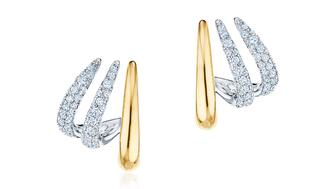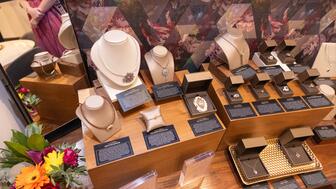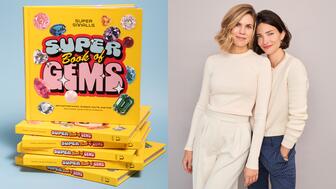She was remembered as a creative and generous woman of faith, who also had a sweet tooth.
Rocks On: Turquoise’s upward trend
The latest installment in the Rocks On series examines current supply and demand for turquoise and displays several pieces of jewelry that highlight the stone’s hues.

Already limited in supply because of its makeup--it’s only found in a few places on Earth, dry, barren regions where copper-rich groundwater seeps down and reacts with minerals to form it--the gemstone is becoming even rarer, as demand continues to grow while supply shrinks.
Turquoise is relatively soft, making it ideal for carving, so it’s not only a good gemstone for jewelry but also for ornamental purposes.
And fittingly, the gem has an important place in history. Its earliest appearances date back to ancient civilizations, from the tombs of Egypt’s pharaohs to being gifted from Aztec emperor Montezuma to Spanish conquistador Hernán Cortés.
Though it remains popular today, it’s more recent history has been a bit rocky.
Following a turquoise craze in the 1970s, it was a number of years before interest in the stone peaked again, according to Richard Shull of Out Of Our Mines, a company that deals in colored gemstones.
It was due to a number of factors that consumers began to look at it again, including a growing interest in its cultural significance and innovative jewelry design. The idea of the stone’s rarity after the closure of a few mines, including Arizona’s Sleeping Beauty, also increased interest. “Collectability tends to drive the high-end market,” Shull said.
The turquoise market has been increasing at a healthy pace since the 1990s, with buyers becoming more educated about what’s on the market.
But the supply of natural turquoise, including both material that needs to be enhanced and that which is naturally hard enough to be gemstone quality, has dwindled in the past few years.
Domestic challenges
One of the top-producing mines, the Sleeping Beauty Mine in Globe, Ariz., which consistently produced large quantities of turquoise with no matrix (the dark veins that run through it) and was considered one of the gemstone’s most important sites, no longer is producing turquoise.
Deriving its name from the fact that that the mine is said to resemble a woman in slumber, the Sleeping Beauty Mine closed in 2012. Within months of its closure, rough from the
Sleeping Beauty turquoise is one of the most valued varieties of the gemstone due to the fact that is has no matrix and is a very clean stone.
When Sleeping Beauty turquoise was in great supply, it was possible to get large high-quality pieces of rough, said Ken Leung of Gleam Gems. Now, since the mine is no longer in operation, anything of that caliber on the market is likely coming from a supplier’s inventory.
Where beads greater than 6 millimeters in size are now considered large, Leung said they used to be able to obtain round beads upwards of 16, 18 or even 20 mm. The mine also was able to serve a variety of markets and price points, providing large quantities of turquoise suitable for treatment as well as natural gem-quality stones.
“We’re not currently aware of another source at this time for this kind of turquoise, so unless something changes and a new supply is found, this will become a lost material, a collector’s item,” Leung said.
Gleam Gems is able to offer Sleeping Beauty turquoise because they have built up a stockpile. But Leung adds that most of the company’s demand these days is coming from overseas, as American consumers are less likely to pay the higher prices that the high-end turquoise gems now demand.
A foreign approach
As domestic supply in the U.S. started drying up, the industry began looking at foreign sources, particularly China. But even these sources are putting less newly mined material into the market today.
Up until about four or five years ago, the turquoise coming from China was both plentiful and relatively inexpensive, according to Shull. Since then, however, little Chinese product has been hitting the market.
Some turquoise still is coming out of China, along with Egypt, Iran and Mexico, in commercial quantities. These days, however, the mining focus mainly is on the southwestern United States
Though it’s of a different variety, much of what is hitting the market as newly mined material currently comes from the deposits of Kingman, Ariz.--though Shull said even that’s mostly enhanced material that needs treatment to be hard enough to be used as gemstones--and a small number of mines still are in production in Nevada.
Maturing markets
The diminishing supply of turquoise in the U.S. and China has led to a “maturing” of the market, as Shull refers to it, with different types of looks being appreciated by various consumer groups as the market slowly moves past fashion-oriented trends.
He adds that they are seeing that European and Middle Eastern buyers generally prefer gem-grade “clear” turquoise while in the U.S. and, to some extent, Japan, the stones with a matrix are preferred.
Though the presence of a matrix in turquoise can lower its value, according to the GIA’s Gem Encyclopedia, stones with the spider-web look still are valued and desired by consumers and designers in certain markets.
Sara Freedenfeld, the designer behind the Amali jewelry line, echoed this sentiment, saying that many of her customers love the look of the Persian turquoise with its very natural matrix.
“First and foremost, I love turquoise because it is such a beautiful color. It’s playful, vibrant, and youthful,” she said. “I think most people associate it with silver, so I love working with it in gold designs because it’s a little unexpected.”
The classic blue turquoise currently is both the most recognized and most popular, especially in the commercial market. Blue-green and green turquoise also has been trending upward as it starts to get used in more designs.
While the high-quality, untreated turquoise that is clean and clear can demand a certain price in today’s market, the untreated gemstones with an even black spider-web matrix also are fetching high prices. Turquoise from some of the Nevada mines, for example, are going for more than $300 per carat, according to Shull.
The gemstone’s future likely depends on many of these smaller mines that still are producing, supplying a variety of quality and types for a wide consumer market, as well as the latest jump in prices somewhat stabilizing itself.
“With certain qualities being relatively inexpensive for many years, many are reluctant to invest the money to carry turquoise in their inventory,” Shull said. “The biggest opportunity is that an increasingly educated public is likely eager to purchase quality turquoise jewelry for its lore as well as its attractive color.”
The Latest

The “Volume 7” bridal catalog features best-selling engagement rings, trending styles, and a new section highlighting anniversary bands.

The New York-based brand is set to launch a limited-time offering for the holiday season at Holt Renfrew in Toronto.

Move over neck mess, the ear story is the way to make a layering statement today.


Holiday sales growth is expected to slow as consumers grapple with inflation and tariff-related uncertainty.

Jamie Turner Designs is among the winners of the local “Austin Shines” contest, hosted by Eliza Page, a jewelry store in Austin, Texas.

With their unmatched services and low fees, reDollar.com is challenging some big names in the online consignment world.

The red and azure colorway is one of many fun enamel pairings offered, bringing whimsy to the classic style of a monogramed signet ring.

A trade deal with Switzerland seems probable, but reaching an agreement with India remains a challenge, David Bonaparte said.

Botswana’s president said his country wants a controlling share, while Angola envisions multiple countries holding minority stakes.

The manufacturer is adding 1,400 chemical vapor deposition (CVD) reactors to its growing facility in India.

The jeweler to the stars has worked with Drake, A$AP Rocky, Tyler the Creator, and other celebrities.

The Scarsdale, New York-based jeweler donated a professional-grade watch cleaning machine.

The 50 percent tariffs on diamonds shipped from India to the U.S. have pushed midstream manufacturers to the edge.

De Beers’ refreshed, multipronged approach, which includes generic promotions and retail partnerships, is delivering positive dividends.
They are trying to balance the need to sustain well-established relationships with the pressure higher tariffs have put on margins.

Jewelry manufacturer Jewelex has partnered with JOSH, an industry training center, on a program for people with disabilities.

The collection includes pieces dating back to the Victorian and Art Deco periods as well as mid-century and late 20th-century designs.

He previously served as co-chair of the nonprofit’s beneficiary committee.

Its second collaboration with the conservationist features jewelry with dove and olive branch motifs.

The diamond manufacturer’s new company will provide accessible and affordable high-quality medicines across India.

Emmanuel Raheb shares tips on how a jeweler’s showcases, marketing, and social media presence can whisper, instead of shout.

The private equity firm has a plan to revive the mall staple.

The “Super Book of Gems” dives into the Mohs Hardness Scale, the Four C’s, and designs from jewelers like Cartier and Bulgari.

Claudio Pasta will take the lead at the Italian fine jewelry brand, succeeding company founder Licia Mattioli.

The new lab-grown diamond jewelry offering is the latest expansion of the designer’s “Bliss” collection.




























